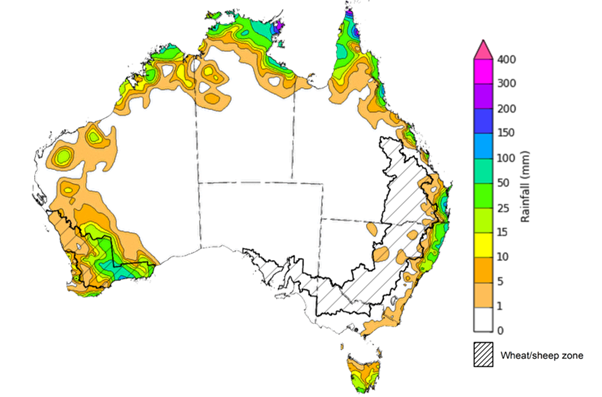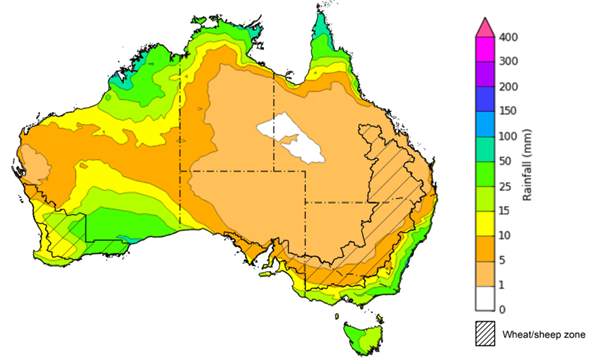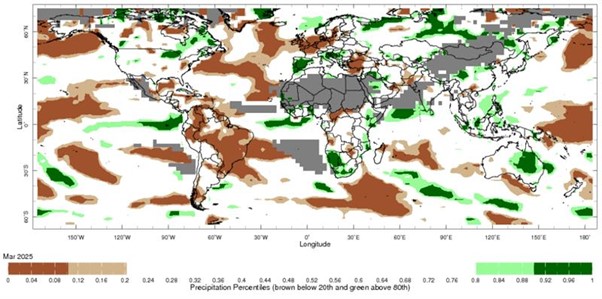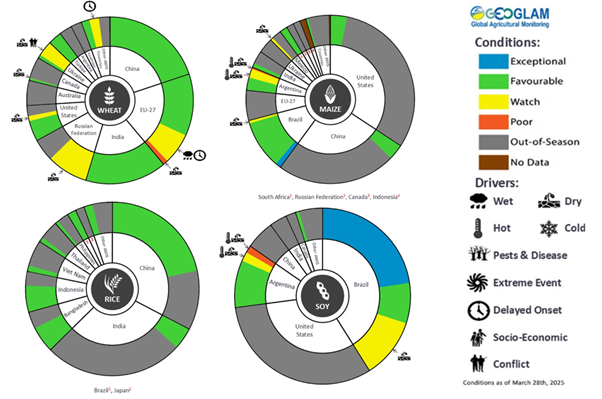Key issues
- In the week ending 16 April 2025 low-pressure systems and troughs brought rainfall to the west, far north and east of Australia.
- Rainfall totals were low in many cropping regions, with exceptions in Western Australia where 5-150 millimetres of rainfall were recorded.
- Little to no rainfall across most eastern cropping regions is likely to contribute to a drawdown in soil moisture and allow for the resumption of the harvest of remaining summer crops.
- Over the coming eight days, wet conditions are expected across parts of western, northern and south-eastern Australia.
- Across cropping regions rainfall totals of between 5-50 millimetres are expected in Western Australia, while remaining cropping regions are likely to see little to no rainfall. The lack of autumn rainfall across large areas of south-eastern Australia continues to present a downside risk to the timely planting of winter crops particularly in areas with low stored soil moisture.
- Rainfall in March 2025 was variable across the world’s major grain- and oilseed-producing regions, leading to differing crop production outcomes.
- Global production conditions were generally favourable for rice and maize, but variable for soybeans and wheat.
- Global production conditions have been slightly more favourable compared to those used to formulate ABARES forecasts of global grain supplies and world prices for 2024–25 in its March 2025 edition of the Agricultural Commodities Report. As a result, global grain and oilseed production are likely to increase slightly compared to those presented in the March forecast, due to slight improvements in global wheat, maize and soybean production.
- Water storage levels in the Murray-Darling Basin (MDB) decreased between 10 April 2025 and 17 April 2025 by 153 gigalitres (GL). Current volume of water held in storage is 11,930 GL, equivalent to 54% of total storage capacity. This is 29 percent or 4,906 GL less than at the same time last year. Water storage data is sourced from the Bureau of Meteorology.
- Allocation prices in the Victorian Murray below the Barmah Choke increased from $193 on 10 April 2025 to $262 on 17 April 2025. Prices are the same in regions above the Barmah choke and below due to the relaxing of constraints for trade between regions, prices are equal in the Murrumbidgee and VIC Murray Below.
Climate
In the week ending 16 April 2025, low-pressure systems and troughs brought rainfall to northern, eastern, and western regions of the country. High-pressure systems kept much of the remainder of Australia largely dry.
- The Northern Tropics, including Cape York Peninsula and the far north of the Northern Territory saw rainfall of between 5-300 millimetres of rainfall, while parts of northern Western Australia recorded between 5-100 millimetres.
- Rainfall totals of between 5-150 millimetres were also recorded across coastal areas of southern Queensland and northern New South Wales, as well as southwest Western Australia. In Tasmania, up to 50 millimetres of rainfall was recorded over the period.
- Little to no rainfall was observed across much of the remainder of the country
Cropping regions were largely dry, with the exception of Western Australia:
- Large areas of southern Western Australia received between 5-150 millimetres, with higher rainfall totals in southeast regions.
- Cropping regions in Queensland, New South Wales, Victoria, and South Australia saw little to no rainfall over the period.
- Little to no rainfall across most eastern cropping regions is likely to contribute to a drawdown in soil moisture and allow for the resumption of the harvest of remaining summer crops.
Rainfall for the week ending 16 April 2025

Issued: 16/4/2025
Note: The rainfall analyses and associated maps utilise data contained in the Bureau of Meteorology climate database, the Australian Data Archive for Meteorology (ADAM). The analyses are initially produced automatically from real-time data with limited quality control. They are intended to provide a general overview of rainfall across Australia as quickly as possible after the observations are received. For further information go to http://www.bom.gov.au/climate/rainfall/
Over the 8 days to 24 April 2025, low-pressure systems and Tropical Cyclone (TC) Errol are expected to bring rainfall to western, northern and south-eastern Australia.
- Falls of between 10-100 millimetres are likely for much of the northern tropics, including the north of the Northern Territory, northern Queensland, and northern Western Australia.
- Southern regions of Western Australia are also expected to receive between 10- 100 millimetres of rainfall.
- The eastern and southern margins of New South Wales, Victoria, and South Australia, as well as much of Tasmania are expected to receive falls of between 5-50 millimetres.
- High-pressure systems are expected to keep most central and eastern regions of the country relatively dry, with 1-10 millimetres of rainfall expected.
Rainfall totals across cropping regions over the coming week are forecast to be low in the east, but higher in the west.
- Rainfall totals of between 5-50 millimetres are expected in Western Australia
- In contrast, remaining cropping regions are expected to receive little to no rainfall, will falls of between 5-15 millimetres expected in Victoria, South Australia and parts of southern New South Wales.
- If realised, these low rainfall totals across Queensland and northern New South Wales are likely to support the uninterrupted competing of summer crop of harvest. However, the lack of autumn rainfall continues to present a downside risk to the timely planting of winter crops particularly in areas with low stored soil moisture.
Total forecast rainfall for the period 17 April to 24 April 2025

Issued 17/4/2025
Note: This rainfall forecast is produced from computer models. As the model outputs are not altered by weather forecasters, it is important to check local forecasts and warnings issued by the Bureau of Meteorology.
Crop production is affected by long-term trends in average rainfall and temperature, interannual climate variability, shocks during specific growth stages, and extreme weather events. Some crops are more tolerant than others to certain types of stresses, and at each growth stage, different types of stresses affect crop species in different ways.
Precipitation anomalies and outlooks presented below indicate the current and expected future production conditions for major grain and oilseed producing countries (responsible for over 80% of global crop production). This is an important input to assessing the global grain supply outlook.
Rainfall in March 2025 was variable across the world’s major grain- and oilseed-producing regions:
- In the southern hemisphere, precipitation was below average across most of Brazil and parts of Argentina. Above average precipitation occurred in parts of southeast Asia, including much of Indonesia, southern Africa and north-eastern Australia. March precipitation was generally average across remaining major southern hemisphere grain- and oilseed-producing regions.
- In the northern hemisphere, precipitation was below average across scattered areas of the United States, parts of northern and south-eastern Europe, and across parts of southern China. Precipitation was above average in the north of the United States, central China and parts of central Europe. March precipitation was generally average across remaining major northern hemisphere grain- and oilseed-producing regions.
Global precipitation percentiles, March 2025

Source: International Research Institute for Climate and Society
As of 28 March 2025, global production conditions were generally favourable for rice and maize, but variable for soybeans and wheat:
- Wheat – Conditions are highly variable in major northern hemisphere growing regions, with winter wheat for harvest in 2025–26 emerging early from dormancy due to warm than condition with dryness negatively impacting yield potential across part of the European Union and the United States, as well as much of Russian Federation, Ukraine and the United Kingdom.
- Maize – Conditions are mixed in the southern hemisphere with some downturns in production expected in parts of northern Brazil and Argentina, while sowing is underway in the northern hemisphere under generally favourable conditions.
- Rice – Conditions are generally favourable for the harvest and planting of wet and dry season rice across most of Southeast Asia, Indonesia and the Americas.
- Soybeans – In the southern hemisphere, harvest is progressing in Brazil under mostly favourable to exceptional conditions. Recent rainfall has improved crop conditions in Argentina.
Crop conditions, AMIS countries, 28 March 2025

Source: AMIS
The global climate outlook for May 2025 to July 2025 indicates that mixed rainfall conditions are expected for the world’s major grain-producing and oilseed-producing regions. Outlooks and potential production impacts for the major grain and oilseed producing countries are presented in the following table.
Rainfall outlook and potential impact on the future state of production conditions, May-July 2025
| Region | May-July rainfall outlook | Potential impact on production |
|---|---|---|
| Argentina | Average rainfall is more likely across much of Argentina. | Average rainfall is likely to support the development of cotton, corn, sorghum, rice and millet, as well as the planting of wheat. |
| Black Sea Region | Below average to average rainfall is expected across much of the Black Sea region. | Below average rainfall in southern parts of Kazakhstan, Ukraine, Turkey and southern Russia may adversely affect grain filling of wheat and canola, as well as cotton, corn and sunflower from July 2025. Average rainfall across remaining areas across the Black Sea region is likely to support the growth of similar crops during this period. |
| Brazil | Below average rainfall likely in southern areas, with much of the remainder of Brazil likely to record average to above average rainfall. | Average to above average rainfall across central and northern Brazil may interrupt the harvesting of cotton and corn. Below average rainfall in the south is likely to impede the germination and establishment of wheat in June and July. |
| Canada | Generally average rainfall is expected over much of Canada. | Average rainfall is likely to be sufficient to support spring wheat and canola flowering in July, and the planting corn and soybeans. |
| China | Above average rainfall is expected throughout much of central and northern China, with below average rainfall expected in the east. | Average to above average rainfall across much China is likely to support the flowering of major crops over the season, including spring wheat, rice, cotton, corn and soybeans. Below average rainfall across parts of eastern China may affect the development of these crops from May 2025. |
| Europe | Average to above average rainfall is likely for most of Europe. | Average rainfall is likely to support the planting and establishment of corn, soybeans and sunflower, as well as the development of canola and winter wheat through critical reproductive stages. |
| South Asia (India) | Average rainfall is expected across much of central India, with areas of the north and south forecast to receive above average rainfall. | Average rainfall is likely to support the vegetative development of major crops, including corn, rice, millet and sorghum. |
| Southeast Asia (SEA) | Average to above average rainfall is likely across much of Indonesia and the Philippines, with below average rainfall expected Malaysia. In the remaining regions, average rainfall if likely. | Average to above average rainfall in SEA may support the flowering of rice and corn in major growing regions. |
| The United States of America (US) | Below average rainfall is likely for much of western and central United States, with average rainfall more likely across the east. | Below average rainfall in western and central areas is likely to impact yield potential of winter wheat as it comes out of dormancy, as well as the planting and development of spring wheat, canola, corn, cotton, and rice. |
Water
Water storages, water markets and water allocations - current week
The Tableau dashboard may not meet accessibility requirements. For information about the contents of these dashboards contact ABARES.
Commodities
Information on weekly price changes in agricultural commodities is now available at the Weekly commodity price update.
